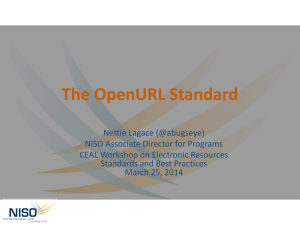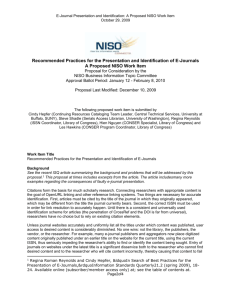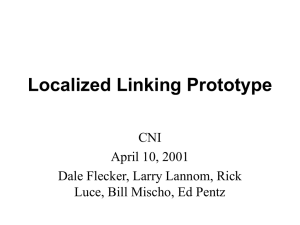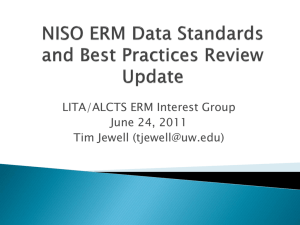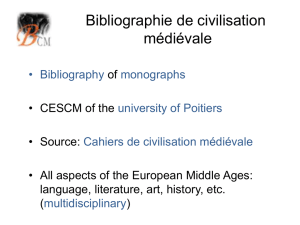presentation slides
advertisement
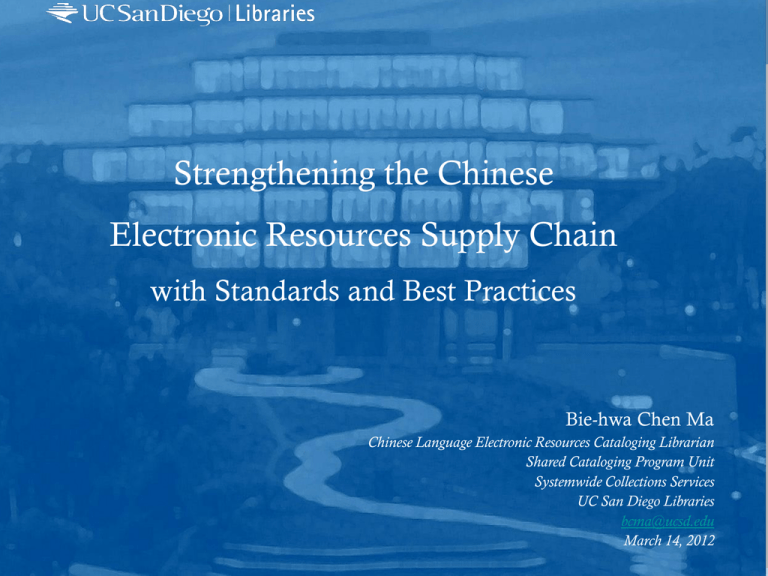
Strengthening the Chinese Electronic Resources Supply Chain with Standards and Best Practices Bie-hwa Chen Ma Chinese Language Electronic Resources Cataloging Librarian Shared Cataloging Program Unit Systemwide Collections Services UC San Diego Libraries bcma@ucsd.edu March 14, 2012 Outline • Chinese E-resources Access and Cataloging Issues • Current Standards & Best Practices – OpenURL and DOI – KBART – PIE-J • Unaddressed Issues and Future Developments • How You Can Help 2 Long-standing Chinese E-resources Cataloging & Access Issues Vendor-provided metadata Content presentation and identification URL and link resolution Others Word division of Pinyin OCLC records Character formats (traditional vs. simplified)… 3 Feasible Collective Resolutions Source of problems All responsible parties in the supply chain Key to win-win solutions: Collaboration Roles in E-resources Supply Chain Feasible solutions OpenURL, KBART, and PIE-J 4 Current Standards & Best Practices 5 Linking Technology Static URL Source Static Link (e.g., http://www.wanfangdata.com/wf/~kjqk/hljda/index.html) Persistent URL (PURL) Source PURL HTTP Redirect Target Target Current URL BibPURL: http://bibpurl.oclc.org/web/42677 http://ej.nict.gov.tw/JTR Digital Object Identifier Persistent Link (DOI System URL + DOI) http://dx.doi.org/10.1007/978-1-4614-1296-0 http://www.springerlink.com/content/m4nk15/#section=957676&page=1 Open URL Source Source link/ (Citation) outbound link/ Source OpenURL (Query) Link Resolver Knowledge Base (K-B) Target link(s)/ inbound links Target OpenURL (output) User Accessible Target(s) (Appropriate Copy/Copies of the resource) OpenURL Standard, Benefits, Linking Practices OpenURL Framework for Context-Sensitive Services Standard Source OpenURL link examples Version 0.1: http://openurl.cdlib.org/ sid=SCP:SCP Version1.0: http://resolver.example.edu/cgi 2004 info:ofi/fmt:kev:mtx:book article Z39.880836218310 utf8 黑龙江档案 The+Far+Side+Gallery+3 OpenURL benefits - Appropriate copies Reduce linking failures Lower link maintenance cost Interoperability for data exchange Linking practices for Chinese resources - Mostly incompliant with DOI or OpenURL Bad quality metadata in K-B 7 KBART recommended best practices Why KBART Knowledge Bases And Related Tools (KBART) Working Group - Launched by UKSG and NISO in 2008 - Goal: to improve the supply of data to link resolvers and knowledge bases - “Phase I Recommended Practice” published in 2010 Phase I Recommendation (Focused on journals) - Exchange method and frequency Data format Fields labels and order Specifics for certain fields 8 KBART Recommendation Exchange Method and Frequency Method: Website or FTP Frequency: Monthly if applicable KBART addresses the Chinese E-resources metadata exchange issues • Mostly by request only • Irregularly and infrequently • Only half of the journal packages in K-B 9 Provider-Supplied Metadata Vs. KBART Mandatory Fields & Data Format: Various data formats Inaccurate ISSN Missing important metadata for KB & cataloging needs (Cells in gray) Non-Roman specific fields to be added? No separate entry for old/new title 10 KBART Recommendation can help eliminate these practices! Title on website Date in the MARC record, 1960 Date on the image of colophon, 1956 Title in the digitized resource 11 Presentation and Identification of E-Journals (PIE-J) Best Practices Presentation and Identification of E-Journals (PIE-J) Working Group: formed by NISO in 2010 Goal: to develop a recommended practice on the presentation and identification of e-journals Best Practices: to be published in 2012 Best Practices highlights • Retention of original title and citation information • Display of correct ISSN, title histories, & publication information • Creation of a presentation for easy access to all content • Digitization consideration 12 PIE-J Best Practices – Title Change A Good Example All content from the former title is presented in a separate website under the title and the identifying citation information it was originally published. Later title Former title 13 PIE-J Best Practices – Citation Output “Ensure that all outputs by the publisher of provider (e.g., Table of Contents alerts, exporting or e-mailing citations of articles) use the journal title and other identifying citation information under which the content was originally published.” The above practices can eliminate the citation problems below. 1. No ISSN 拼音 [Pin yin] 1956-1957 2. 0511-4764 文字改革 [Wen zi gai ge] 1957-1985 3. 1001-8476 语文建设 [Yu wen jian she] 1986RefWorks output for the 2nd article Saved search results from different titles presented and listed under latest title Renumbered by the provider. Cited under the latest title 14 PIE-J Best Practices – Journal History & ISSN “Provide a journal title history. Include the full journal title, publication date range, and ISSN for the current title” Best example among Chinese journal packages Good example of best practice 15 PIE-J – Keep identifying information consistent across all versions “Retain content once it is published, whether digitized from the print or born digital. Do not remove, rename, or renumber content. ” Bad practices that could have been eliminated. Package A: Package B: 16 PIE-J Best Practices – Digitize from Cover to Cover “Digitize the entire original volume or issue, front and back covers, and all internal pages, including blank or nearly blank pages, and advertisements ” The only one and best example from DragonSource 17 Unaddressed Issues/Future Developments Pinyin word division discrepancy 中国史研究动态 Vendor SFX ISSN OCLC Zhongguo Shi Yanjiu Dongtai zhong guo shi yan jiu dong tai Zhongguoshi yanjiu dongtai Zhongguo shi yan jiu dong tai Chinese E-books presentation • Missing content • Resolution requirement Underway KBART phase II IOTA Data covered by labels from a library 18 How you can help • Work with the standards & best practices in mind – – – – Catalogers: Create records with accurate and most complete metadata Acquisitions: Connect content and K-B providers Bibliographers: Incorporate them into contracts wherever possible Content providers/Publishers/K-B team/A & I Services/Search engine providers: Endorse standards and practices as they are to your benefits! For everyone: • Report metadata errors • Promotion and adoption of standards and best practices – Pass information and provide education if necessary – Recognize providers/publishers who adopt them e.g., KBART logo: – Use them as communication tools among relevant parties 19 How you can help (cont.) • Participate in the public review of the best practices • Get Involved with future developments • Input your ideas on forming a CJK working group – Sponsors – Members – Charge • Identify CJK-specific issues • Recommend CJK-specific best practices • Work as a liaison between CEAL and related working groups … • Your continued support! 20 Recommended Readings • • Glasser, S. (2012). Broken links and failed access : how KBART, IOTA, and PIE-J can help. Library resources & technical services, 56(1), 14-23. OpenURL Framework for Context-Sensitive Services http://www.niso.org/apps/group_public/download.php/6640/The%20OpenURL %20Framework%20for%20Context-Sensitive%20Services.pdf • • DOI http://www.doi.org/, http://www.crossref.org/ Knowledge bases and related tools : a recommended practice of the National Information Standards Organization (NISO) and UKSG http://www.uksg.org/sites/uksg.org/files/KBART_Phase_I_Recommended_Pract ice.pdf KBART: endorsement http://www.niso.org/workrooms/kbart/endorsement/ • Presentation and Identification of E-Journals (PIE-J) http://www.niso.org/workrooms/piej http://www.slideshare.net/twissbrooks/best-practices-for-presentation-of-e-journals-part-1 http://www.slideshare.net/twissbrooks/best-practices-for-presentation-of-e-journals-part-2 • IOTA: Improving OpenURLs Through Analytics http://www.niso.org/workrooms/openurlquality/ 21 Q&A Bie-hwa Ma 22 bcma@ucsd.edu

